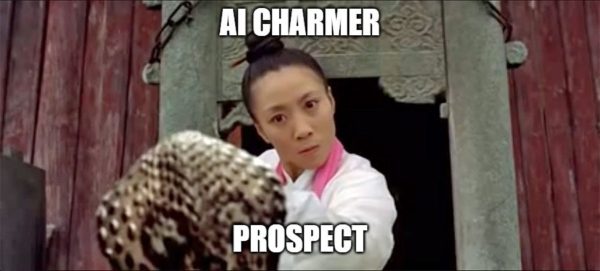Reading Time : 0 Mins
AI Charmer Or AI Realist ?
Bibliophile, Movie buff & a Passionate Storyteller.
I am sure most of you readers are familiar with the image above. Yes, it is from “The Karate Kid” movie(Jaden Smith, Jackie Chan version). Try googling “snake scene from the karate kid” and you will get several responses right from the spiritual nature of this scene to how you can get killed by a cobra in the process of doing an act like this to animal cruelty.
Well, I was tempted to write about the Vedantic doctrine of “Advaita” regarding the context of this scene from the movie, but controlled my urge as I felt that it resonates a lot more with a hot topic in my profession at the moment, “Artificial Intelligence or AI”. I am no AI expert and so think of my opinions below as one from an amateur with limited experience (for about 2 years now) hearing, talking and working with some knowledgeable minds on AI.
There are two types of AI sellers today. Number one, who consider AI to be the “silver bullet” for all problems and Number two, “who don’t think AI can solve all problems”. I prefer to call the first category as “AI Charmers” and the second as “AI Realists”.

Now, how do you identify an “AI Charmer” versus an “AI Realist”. The “AI Charmer” usually exhibits the following traits:
A. Talks about global AI trends, have a lot of data points about the influence of AI and cites industry reports that describe how AI is changing everything.
B. How AI can be the game-changer in addressing problems that have been around for a long time now.
C. The solutions the “AI Charmer” describes are completely in line with what the prospect is looking for.
On the other hand, “AI Realist” can be identified with the following behaviors:
A. After carefully considering your problem statement recommends a “rule-based system” or something similar that would address your need or if you really need AI. Gives substantial reasoning for the decision and stands by it.
B. If convinced that you need an AI system, explains how it can help you but also gives a word of caution on the challenges associated with it such as improving accuracy over time, quality of data needed to build “self-trained” models for betterment, etc.
C. Recommends that you use the AI system as a complementary setup to your current system for some time to monitor data comparison and build enough confidence before you can completely replace it.
D. It signifies the importance of data and why limited data can impact using AI.
So, if you are part of an AI conversation next time, try to identify if you are talking to a “Charmer” or a “Realist”.
Misconceptions lead to the conflict scenario of Expectations vs. Reality. Watch our webinar to know how to leverage AI from the industry experts.
Related Posts





















